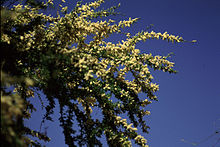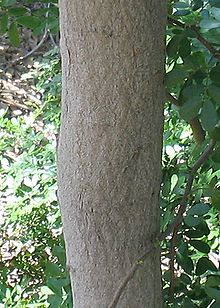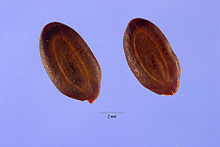- Acacia rigidula
-
Acacia rigidula 
Conservation status Scientific classification Kingdom: Plantae (unranked): Angiosperms (unranked): Eudicots (unranked): Rosids Order: Fabales Family: Fabaceae Genus: Acacia Species: A. rigidula Binomial name Acacia rigidula
Benth.Synonyms Acaciopsis rigidula (Benth.) Britton & Rose
Vachellia rigidula (Benth.) Seigler & Ebinger[2]Acacia rigidula, commonly known as Blackbrush Acacia or Chaparro Prieto, is a species of shrub or small tree in the legume family, Fabaceae. Its native range stretches from Texas in the United States south to central Mexico.[2] This perennial is closely related to A. berlandieri and is not listed as being threatened.[3] It reaches a height of 5–15 feet (1.5–4.6 m).[4] Blackbrush Acacia grows on limestone hillsides and canyons.[5]
Contents
Phytochemistry
A 1998 paper in the journal Phytochemistry indicates that the leaves and stems of A. rigidula contain 40 alkaloids and amines,[6] including:
- 3,4,5-Trihydroxy-phenethylamine (demethylated mescaline)[7]
- Methamphetamine
- Anhalamine[7]
- Beta-methyl-phenethylamine[7]
- Catechin[7]
- Dimethyltryptamine – 323.8 ppm spring, 568.4 ppm fall[6]
- Fisetin[7]
- Hordenine[7]
- Mescaline[7]
- N-Methyltryptamine – 4.6 ppm spring, 54.9 ppm fall[6]
- Nicotine[7]
- Nornicotine[7]
- Phenethylamine[7] – 2314.6 ppm spring, 5264.8 ppm fall[6]
- Quercetin[7]
- Tyramine[7]
- Tryptamine – 0.8 ppm spring, 21.2 ppm fall[6]
These findings have never been confirmed or discussed and are considered by some to be unlikely and a product of contamination or a hoax. Some of the apparently found phenylethylamines were previously only known as man-made and their discovery would have been quite revolutionary. Also the authors of the 1998 study did not answer written requests.[8]
Uses
Blackbrush Acacia is used in weight loss dietary supplements because of its adrenergic amine content. These substances stimulate beta-receptors to increase lipolysis and metabolic rate and decrease appetite.[9]
References
- ^ "Acacia rigidula - Benth. Blackbrush Acacia". NatureServe Explorer. NatureServe. http://www.natureserve.org/explorer/servlet/NatureServe?sourceTemplate=tabular_report.wmt&loadTemplate=species_RptComprehensive.wmt&selectedReport=RptComprehensive.wmt&summaryView=tabular_report.wmt&elKey=154786&paging=home&save=true&startIndex=1&nextStartIndex=1&reset=false&offPageSelectedElKey=154786&offPageSelectedElType=species&offPageYesNo=true&post_processes=&radiobutton=radiobutton&selectedIndexes=154786. Retrieved 2010-10-17.
- ^ a b "Taxon: Acacia rigidula Benth.". Germplasm Resources Information Network. United States Department of Agriculture. 1999-09-09. http://www.ars-grin.gov/cgi-bin/npgs/html/taxon.pl?406135. Retrieved 2010-10-17.
- ^ ILDIS LegumeWeb
- ^ "Acacia rigidula Benth.". Native Plant Database. Lady Bird Johnson Wildflower Center. http://www.wildflower.org/plants/result.php?id_plant=ACRI. Retrieved 2009-06-30.
- ^ "Blackbrush Acacia, Chaparro Prieto, Catclaw, Gavia". Texas Native Plants Database. Texas A&M University. http://aggie-horticulture.tamu.edu/ornamentals/nativeshrubs/acaciarigid.htm. Retrieved 2009-06-30.
- ^ a b c d e Clement, Beverly A.; Christina M. Goff and T. David A. Forbes (1998). "Toxic Amines and Alkaloids from Acacia rigidula" (PDF). Phytochemistry 49 (5): 1377–1380. doi:10.1016/S0031-9422(97)01022-4. http://designer-drugs.com/pte/12.162.180.114/dcd/pdf/acacia.rigidula.pdf.
- ^ a b c d e f g h i j k l Forbes, T.D.A.; B.A. Clement (PDF). Chemistry of Acacia's from South Texas. Texas A&M Agricultural Research & Extension Center at Uvalde. http://uvalde.tamu.edu/pdf/chemtdaf.pdf.
- ^ "Acacias and Natural Amphetamine". Ask Dr. Shulgin Online. Center for Cognitive Liberty and Ethics. 2001-09-26. http://www.cognitiveliberty.org/shulgin/adsarchive/acacia.htm.
- ^ WO application 2006099274, Jared R. Wheat, "Dietary Supplement and Method of Using Same", published 2006-09-14
External links
 Media related to Acacia rigidula at Wikimedia Commons
Media related to Acacia rigidula at Wikimedia Commons  Data related to Acacia rigidula at WikispeciesCategories:
Data related to Acacia rigidula at WikispeciesCategories:- NatureServe Secure species
- Acacia
- Plants described in 1842
- Shrubs
- Trees of Texas
- Trees of Mexico
- Trees of Coahuila
- Trees of Michoacán
- Trees of Nuevo León
- Trees of San Luis Potosí
- Trees of Tamaulipas
- Trees of Veracruz
- Entheogens
- Forages
- Acacia stubs
Wikimedia Foundation. 2010.




